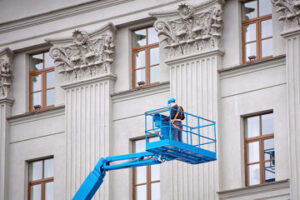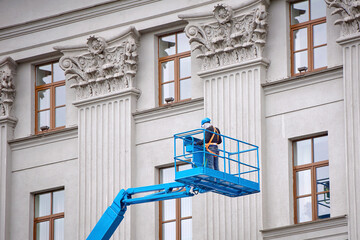Stucco naturally deters fire, rot, mold and termite infestations. However, stucco must be inspected for damage regularly to prevent moisture intrusion. A homeowner can inspect stucco walls by noticing warning signs such as dark spots, stains or cracks under windows (known as “Stucco Tears”). Untreated moisture problems behind stucco can lead to wall rot and costly repairs. Check out Stucco Repair Philadelphia to learn more.
 Stucco is one of the most popular home siding materials, creating a look that is nothing short of spectacular. But, like anything else, it can be damaged by water intrusion, and that damage will get worse over time if not addressed. Here are some signs that your stucco is in need of repair:
Stucco is one of the most popular home siding materials, creating a look that is nothing short of spectacular. But, like anything else, it can be damaged by water intrusion, and that damage will get worse over time if not addressed. Here are some signs that your stucco is in need of repair:
The first sign you should be looking out for is cracks in the surface of your stucco. These cracks are a surefire sign that the underlying structure is compromised. If you notice a few cracks around your home, contact a stucco specialist to assess the extent of the problem.
Another good indicator that you have a stucco problem is if the material looks wet a few days after it rains. This is a surefire sign that the underlying material is saturated, which will cause it to fail in the long run.
You should also look for a white, crystalline substance on the surface of your stucco. This is known as efflorescence, and it is a common symptom of water damage in stucco walls. Efflorescence occurs when the salts in the wall are dissolved by water that seeps through the stucco and evaporates. The dissolved salts are then left on the surface of the wall in a powdery or fuzzy/fluffy form.
Other symptoms of water penetration into your stucco include a musty smell in the house, mold and fungus growth on and inside the walls, and dry rot in or around windows and doors. You should also pay attention to the drywall behind your home’s windows and doors to see if it feels soft to the touch. This is a surefire sign that you have a moisture problem in your stucco, and it needs to be remedied as soon as possible.
Remediation of a stucco problem involves removing the damaged layers to expose the base layer. This layer is then treated to prevent future water intrusion. Remediation is generally preferred to repair, as it is quicker and cheaper. If you think that you have a moisture problem in your house, contact a stucco specialist right away to see which solution is best for you.
Impact Damage
Damage to your stucco walls from outside forces can be extremely damaging. A stray baseball or lawnmower may leave behind a small nick that eventually develops into a crack. A more serious problem may be caused by a car backing into your home or furniture that falls against the wall. A qualified stucco repair contractor will be able to assess the damage and determine whether it is reparable.
Stucco repair differs from remediation in that repairs are a surface level fix. A professional can use a masonry chisel to chip away any old or loose stucco, then use a trowel to apply a layer of mud over the damaged area. This first coat is known as the scratch coat, and it is important to scratch grooves into the mud to help future coats adhere better. After the scratch coat dries, it is time to add another layer of stucco. This second coat is called the brown coat, and it is a good idea to apply this using a float or wire brush. This is the coating that creates your stucco’s texture, so it is vitally important to match it to your existing color scheme.
A few minor cracks are normal, but you should always get these repaired right away as soon as you notice them. Small cracks can widen quickly, and this can lead to serious water intrusion problems. If you see any cracks that are more than a hairline in width, contact a Walpole stucco repair professional to examine the damage.
Crumbling or loose stucco can cause water intrusion and other problems that should be addressed immediately. Loose sections of stucco are often the result of pest infestations, ground vibrations, settling and even age, so it is important to contact a knowledgeable stucco repair professional to examine the damage.
Many DIYers attempt to tackle stucco repair, but it is important to remember that this type of work requires specialized knowledge and experience. Trying to save money by purchasing and applying store-bought stucco repair products can actually increase your costs because they will not fix the underlying issues that are causing the damage.
Woodpecker Damage
Stucco is a durable material, but it can still be damaged. The key is to catch damage early and to repair it quickly before the problem gets worse. There are many types of stucco damage and repair, but some of the most common problems include spider cracking, woodpecker holes and leaking interior walls or ceilings caused by trapped moisture behind the stucco.
Spider cracking: This type of damage happens when the base coat underneath the top stucco layer fails to cure properly. It can happen for a variety of reasons, including poor weather conditions on the day it was applied, an incorrect mixture in the stucco recipe or the mix drying too fast. When this type of damage occurs, a complete reapplication of the stucco is necessary.
Woodpecker Damage: This is a difficult problem to deal with, and it’s important to catch the holes before they get too large. You can use motion-activated sprinklers, metallic covers and repellant paint to deter woodpeckers from pecking holes in your stucco. However, holes are not only unsightly, they can lead to mold and water intrusion which can damage and discolor the stucco.
A professional stucco contractor can help you spot the signs of damage and make repairs before they get too out of hand. Look for any areas where the stucco seems to be bubbling or buckling, as well as dark spots around light fixtures or other wall penetrations. Also be sure to check your gutters regularly to ensure that they’re not clogged, broken or leaking and that they are not causing water to seep under the stucco.
The best way to repair stucco holes is to re-apply the EIFS (Exterior Insulated Finish Systems) system. This is a much faster and less expensive process than remediation, but only if the damage is caught early. The first step is to remove any loose or rotting materials from the hole, then apply a bonding agent and a thin strip of textured fiberglass backed by EIFS to the lath. A layer of grade-D builder’s paper is then tucked into the gap and affixed with roofing nails. Next, a thicker coating of textured EIFS is then applied to the area. This will cover the damaged surface and will deter future woodpecker damage.
Moisture Buildup
Moisture buildup can be as much of a problem for stucco as impact damage. If left untreated it will eventually lead to mold and mildew which can rot the sheathing behind the stucco. Moisture also causes stucco to deteriorate, peel and crack.
It is important to check the surface of your Las Cruces home for signs of moisture damage at least twice a year. Moisture damage to stucco is usually easy to spot and should be repaired immediately before it gets worse. Moisture damage to stucco often results from poor waterproofing or lack of maintenance.
If you don’t look for moisture damage to your stucco it can be very difficult to repair later. Especially when water leaks are allowed to go on for long periods of time. Moisture that builds up in and behind stucco does not dry out easily, and is a huge source of damage to your home.
Some signs of moisture damage are cracks, discoloration and efflorescence. Cracks in the stucco are often hairline fissures, but may also be patterned. Patterned cracks can occur when the foam trim and the stucco didn’t meet properly during installation. Spider cracks can also indicate that the base coat wasn’t cured properly during installation.
Discoloration is often a sign of a moisture problem and can be caused by algae, salts or fungi. Fungi typically form when the spores are trapped in a moist environment. Surface mold is another common sign of a moisture problem. This can be a light green or black color and is easy to remove with the use of a power washer.
Moisture behind the stucco can be caused by gaps around pipe flashing and by sheathing that isn’t sealed correctly. Gaps are common where water pipes, hose bibs and electrical conduit run through stucco walls. Sheathing should be sealed with high-quality caulking to prevent water seepage.
Stucco can be protected by keeping the sheathing sheath free of debris and weeds and by removing any tree branches or shrubs that rub against it. It is also very important to have gutters that are not clogged or damaged and to keep window boxes, planters and other accessories from rubbing against the stucco.

